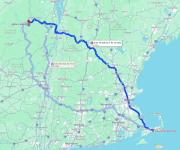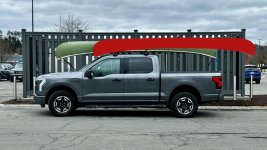I have a '23 Ford F150 Lightning and used it for a canoe trip for first time in early April. I drove from southeast Massachusetts to the Adirondacks: 358 miles, taking the northern route through New Hampshire and Vermont. We put in on the Raquette River, at Axton Landing. I love my truck, but will will try to refrain from subjective commentary and just provide data and feedback that might help other canoeists.

My truck has the smaller of Ford's two battery options: an 98 kilowatt-hour (kWh) pack that Ford and the EPA say yields a 230 mile range estimate, predicated on a 1,000 lb. payload, including passengers. That further assumes no trailers and/or other adornments that might increase wind drag. Ford's other larger battery option is an 131kWh pack that yields an estimated 300 mile range.
In actuality, on the highway, the truck generally averages about 1.8-1.9 miles per kilowatt-hour (mi/kWh) which, if you do the math, yields a range of 176-186 miles at highway speeds (call it 70 mph average). Cold temperatures can further degrade that range, but on a road trip the battery stays warm by way of charging and use, so that factor is offset somewhat.
For a canoe trip, we increased our drag considerably by car-topping an Old Town Tripper. The effect was a reduction in mileage from 1.8mi/kWh to 1.6 mi/kWh, about 11%.
As further context, I cartop my canoe on Rhino Rack roof legs connected by a couple bars of Unistrut. The perforated Unistrut bars made a lot of noise (like the humming when you blow over the top of a beer bottle), so I taped over the holes with gorilla tape. That quieted everything right down. I also strap the bow and stern via the boat's lining holes and that keeps the canoe a lot more stable and in tension. We began the trip with webbing straps on the bow and stern and then switched to rope, which was buffeted around less by the wind at highway speeds. I have a tonneau cover over the truck bed.

We made four charging stops on each leg of the trip (8 total). The drive was 7 hours and we added about 3 hours of charging on top of the drive time each way, so it ended up being a 10 hour trip. During charging, we ate meals, did a little mobile-work and stretched our legs.
This was my first big road trip and I was apprehensive about charging in the Adirondacks but planned ahead with the myriad apps available for electric vehicle trip planning and new it was feasible. To alleviate my nagging concern, I brought a portable generator and a portable charger as an insurance-policy-of-last-resort, but in reality the amperage outputs needed to charge at any reasonable speed are such that doing so is impractical on a road trip.
Every electric vehicle has a certain plug type and not all chargers are available to all vehicles (though the industry is consolidating around certain standards and adapters, so that is starting to change). So, the last charging station available to my truck, before entering the charging-void that is the Adirondacks, was at the Stewart's Shop gas station in Keene, NY, across from the Fire Department. From there, I was able to travel the 38 miles to the put-in and then drive another 38 miles back to Keene after our trip was done to charge again with plenty of range leftover.
Some conclusions: Overall, this sort of a trip is feasible but takes longer and requires more planning than with a gas vehicle. The vehicle's range, and the dearth of charging infrastructure in the rural/wilderness areas, precludes any truly remote destinations. On balance, I had fun with this experimental first trip, but as a canoeist that enjoys remote wilderness, I'm glad I can still borrow my wife's gas car when needed.

My truck has the smaller of Ford's two battery options: an 98 kilowatt-hour (kWh) pack that Ford and the EPA say yields a 230 mile range estimate, predicated on a 1,000 lb. payload, including passengers. That further assumes no trailers and/or other adornments that might increase wind drag. Ford's other larger battery option is an 131kWh pack that yields an estimated 300 mile range.
In actuality, on the highway, the truck generally averages about 1.8-1.9 miles per kilowatt-hour (mi/kWh) which, if you do the math, yields a range of 176-186 miles at highway speeds (call it 70 mph average). Cold temperatures can further degrade that range, but on a road trip the battery stays warm by way of charging and use, so that factor is offset somewhat.
For a canoe trip, we increased our drag considerably by car-topping an Old Town Tripper. The effect was a reduction in mileage from 1.8mi/kWh to 1.6 mi/kWh, about 11%.
As further context, I cartop my canoe on Rhino Rack roof legs connected by a couple bars of Unistrut. The perforated Unistrut bars made a lot of noise (like the humming when you blow over the top of a beer bottle), so I taped over the holes with gorilla tape. That quieted everything right down. I also strap the bow and stern via the boat's lining holes and that keeps the canoe a lot more stable and in tension. We began the trip with webbing straps on the bow and stern and then switched to rope, which was buffeted around less by the wind at highway speeds. I have a tonneau cover over the truck bed.

We made four charging stops on each leg of the trip (8 total). The drive was 7 hours and we added about 3 hours of charging on top of the drive time each way, so it ended up being a 10 hour trip. During charging, we ate meals, did a little mobile-work and stretched our legs.
This was my first big road trip and I was apprehensive about charging in the Adirondacks but planned ahead with the myriad apps available for electric vehicle trip planning and new it was feasible. To alleviate my nagging concern, I brought a portable generator and a portable charger as an insurance-policy-of-last-resort, but in reality the amperage outputs needed to charge at any reasonable speed are such that doing so is impractical on a road trip.
Every electric vehicle has a certain plug type and not all chargers are available to all vehicles (though the industry is consolidating around certain standards and adapters, so that is starting to change). So, the last charging station available to my truck, before entering the charging-void that is the Adirondacks, was at the Stewart's Shop gas station in Keene, NY, across from the Fire Department. From there, I was able to travel the 38 miles to the put-in and then drive another 38 miles back to Keene after our trip was done to charge again with plenty of range leftover.
Some conclusions: Overall, this sort of a trip is feasible but takes longer and requires more planning than with a gas vehicle. The vehicle's range, and the dearth of charging infrastructure in the rural/wilderness areas, precludes any truly remote destinations. On balance, I had fun with this experimental first trip, but as a canoeist that enjoys remote wilderness, I'm glad I can still borrow my wife's gas car when needed.

